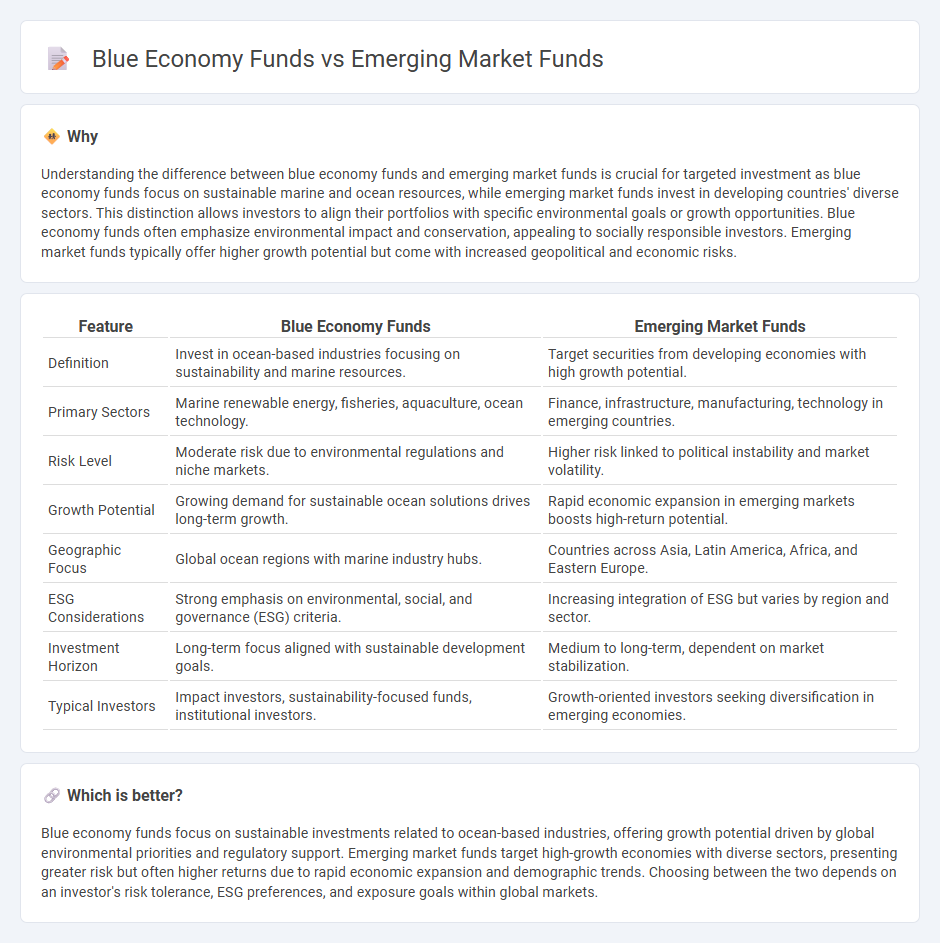
Blue economy funds target investments in sustainable ocean-based industries, emphasizing marine conservation, renewable energy, and sustainable fisheries to capitalize on the growing global demand for eco-friendly solutions. Emerging market funds focus on equities and bonds in developing countries, seeking higher growth potential driven by expanding economies, urbanization, and demographic trends. Explore further to understand which fund aligns best with your investment goals.
Why it is important
Understanding the difference between blue economy funds and emerging market funds is crucial for targeted investment as blue economy funds focus on sustainable marine and ocean resources, while emerging market funds invest in developing countries' diverse sectors. This distinction allows investors to align their portfolios with specific environmental goals or growth opportunities. Blue economy funds often emphasize environmental impact and conservation, appealing to socially responsible investors. Emerging market funds typically offer higher growth potential but come with increased geopolitical and economic risks.
Comparison Table
| Feature | Blue Economy Funds | Emerging Market Funds |
|---|---|---|
| Definition | Invest in ocean-based industries focusing on sustainability and marine resources. | Target securities from developing economies with high growth potential. |
| Primary Sectors | Marine renewable energy, fisheries, aquaculture, ocean technology. | Finance, infrastructure, manufacturing, technology in emerging countries. |
| Risk Level | Moderate risk due to environmental regulations and niche markets. | Higher risk linked to political instability and market volatility. |
| Growth Potential | Growing demand for sustainable ocean solutions drives long-term growth. | Rapid economic expansion in emerging markets boosts high-return potential. |
| Geographic Focus | Global ocean regions with marine industry hubs. | Countries across Asia, Latin America, Africa, and Eastern Europe. |
| ESG Considerations | Strong emphasis on environmental, social, and governance (ESG) criteria. | Increasing integration of ESG but varies by region and sector. |
| Investment Horizon | Long-term focus aligned with sustainable development goals. | Medium to long-term, dependent on market stabilization. |
| Typical Investors | Impact investors, sustainability-focused funds, institutional investors. | Growth-oriented investors seeking diversification in emerging economies. |
Which is better?
Blue economy funds focus on sustainable investments related to ocean-based industries, offering growth potential driven by global environmental priorities and regulatory support. Emerging market funds target high-growth economies with diverse sectors, presenting greater risk but often higher returns due to rapid economic expansion and demographic trends. Choosing between the two depends on an investor's risk tolerance, ESG preferences, and exposure goals within global markets.
Connection
Blue economy funds and emerging market funds are connected through their focus on sustainable development and economic growth in coastal and developing regions. Blue economy funds invest in industries like marine conservation, renewable ocean energy, and sustainable fisheries, which are often concentrated in emerging markets with abundant natural resources. Emerging market funds provide capital to these regions, enabling blue economy initiatives to thrive and contribute to long-term environmental and financial returns.
Key Terms
Emerging Market Funds:
Emerging Market Funds invest primarily in securities from developing economies with high growth potential, such as China, India, and Brazil, offering exposure to dynamic markets and higher returns coupled with increased risks. These funds capitalize on rapid industrialization, urbanization, and expanding consumer bases, driving economic expansion and investment opportunities. Discover how Emerging Market Funds can diversify your portfolio and enhance growth potential.
Growth Potential
Emerging market funds capitalize on rapid economic expansion in developing countries, offering high growth potential driven by industrialization, urbanization, and increasing consumer demand. Blue economy funds invest in sustainable ocean-based industries, targeting long-term growth through innovative sectors like marine biotechnology, fisheries, and renewable ocean energy. Explore more to understand how these funds align with your investment goals and risk tolerance.
Political Risk
Emerging market funds frequently encounter heightened political risk due to unstable governance, regulatory changes, and geopolitical tensions that can impact returns significantly. In contrast, blue economy funds, centered on sustainable ocean-based industries, tend to face political risks tied to maritime policies, environmental regulations, and international ocean governance. Explore how these distinct risk profiles influence investment strategies and outcomes in both fund categories.
Source and External Links
Emerging Market Funds | Franklin Templeton - Franklin Templeton's emerging market funds invest across various industries, countries, and regions to help diversify portfolios and reduce risk.
Emerging Markets Fund | MADCX | Institutional - BlackRock - BlackRock's Emerging Markets Fund aims to outperform the MSCI Emerging Markets Index by combining top-down macro views with in-depth fundamental research, with a net expense ratio of 0.87%.
Emerging Markets 2x Strategy - A Class - Guggenheim Investments - Guggenheim's fund seeks to deliver twice the daily performance of the S&P Emerging 50 ADR Index, with a higher net expense ratio of 1.84%, reflecting its leveraged investment approach.
 dowidth.com
dowidth.com